中外大学生对比
- 格式:ppt
- 大小:5.85 MB
- 文档页数:36

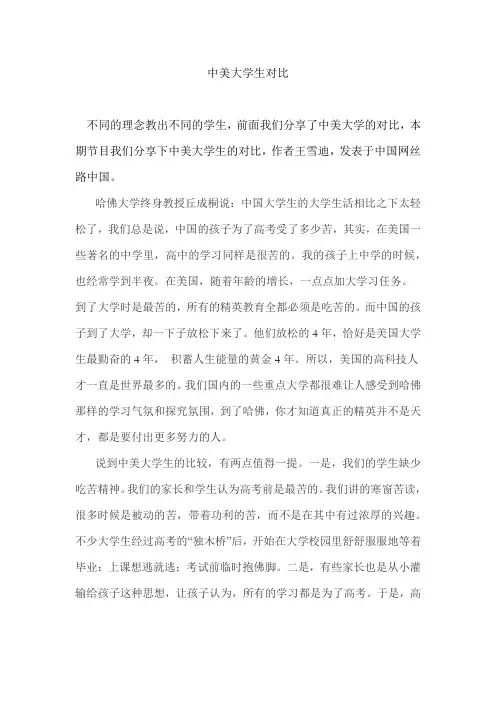
中美大学生对比不同的理念教出不同的学生,前面我们分享了中美大学的对比,本期节目我们分享下中美大学生的对比,作者王雪迪,发表于中国网丝路中国。
哈佛大学终身教授丘成桐说:中国大学生的大学生活相比之下太轻松了,我们总是说,中国的孩子为了高考受了多少苦,其实,在美国一些著名的中学里,高中的学习同样是很苦的。
我的孩子上中学的时候,也经常学到半夜。
在美国,随着年龄的增长,一点点加大学习任务。
到了大学时是最苦的,所有的精英教育全都必须是吃苦的。
而中国的孩子到了大学,却一下子放松下来了。
他们放松的4年,恰好是美国大学生最勤奋的4年,积蓄人生能量的黄金4年。
所以,美国的高科技人才一直是世界最多的。
我们国内的一些重点大学都很难让人感受到哈佛那样的学习气氛和探究氛围,到了哈佛,你才知道真正的精英并不是天才,都是要付出更多努力的人。
说到中美大学生的比较,有两点值得一提。
一是,我们的学生缺少吃苦精神。
我们的家长和学生认为高考前是最苦的。
我们讲的寒窗苦读,很多时候是被动的苦,带着功利的苦,而不是在其中有过浓厚的兴趣。
不少大学生经过高考的“独木桥”后,开始在大学校园里舒舒服服地等着毕业:上课想逃就逃;考试前临时抱佛脚。
二是,有些家长也是从小灌输给孩子这种思想,让孩子认为,所有的学习都是为了高考。
于是,高考结束,学习变得不再重要。
而在美国大学,尤其是精英云集的大学所要付出的苦是我们想象不到的。
当美国大学生带着浓厚的兴趣,积聚能量,为步入社会工作做准备的时候,身为中国的大学生却长长地舒了口气,觉得我终于可以好好休息休息了。
中国式的教育让学生在高考前“用力”过猛,在该储备能力的阶段不仅没有积蓄能量,而是大量消耗了这种能量。
一位中国旅美教师说,中国学生在大学阶段被美国学生远远地甩在了后面。
其根源还在于我们的基础教育。
美国小学是知识的吝啬鬼,严格限制孩子得到知识的数量,一个月只允许孩子得到一个知识,孩子每得到一个知识都需要付出很多的汗水和辛苦;在这个过程中,动手、思考和感悟比知识本身更重要,孩子对知识总是有渴望的感觉。
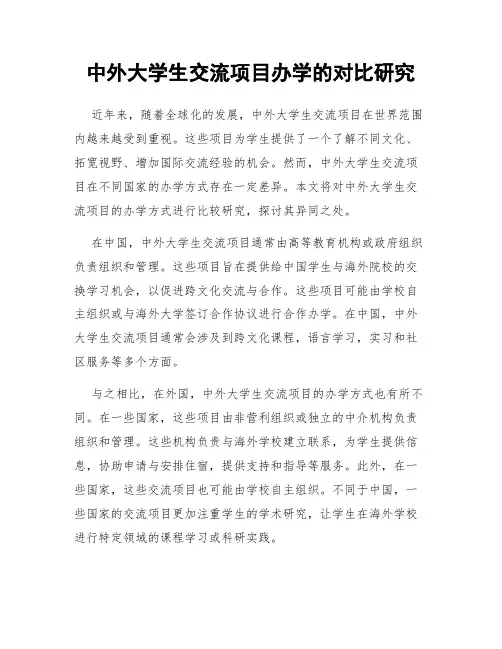
中外大学生交流项目办学的对比研究近年来,随着全球化的发展,中外大学生交流项目在世界范围内越来越受到重视。
这些项目为学生提供了一个了解不同文化、拓宽视野、增加国际交流经验的机会。
然而,中外大学生交流项目在不同国家的办学方式存在一定差异。
本文将对中外大学生交流项目的办学方式进行比较研究,探讨其异同之处。
在中国,中外大学生交流项目通常由高等教育机构或政府组织负责组织和管理。
这些项目旨在提供给中国学生与海外院校的交换学习机会,以促进跨文化交流与合作。
这些项目可能由学校自主组织或与海外大学签订合作协议进行合作办学。
在中国,中外大学生交流项目通常会涉及到跨文化课程,语言学习,实习和社区服务等多个方面。
与之相比,在外国,中外大学生交流项目的办学方式也有所不同。
在一些国家,这些项目由非营利组织或独立的中介机构负责组织和管理。
这些机构负责与海外学校建立联系,为学生提供信息,协助申请与安排住宿,提供支持和指导等服务。
此外,在一些国家,这些交流项目也可能由学校自主组织。
不同于中国,一些国家的交流项目更加注重学生的学术研究,让学生在海外学校进行特定领域的课程学习或科研实践。
在办学方式上的差异之外,中外大学生交流项目还存在一些共同点。
无论是在中国还是在其他国家,这些项目都着力于培养学生的跨文化交流能力和国际视野,以及促进不同国家青年之间的友谊与合作。
这些项目通常提供了丰富的文化交流活动,例如参观当地景点、拜访企业或机构、参加语言交换活动等,让学生在不同文化背景下互相了解和学习。
另外,中外大学生交流项目的学术认可也是一个普遍关注的问题。
在中国,许多学校会将海外交流学习的学分纳入到学生的学业成绩中,并在毕业证书上注明相关内容。
而在外国,学生通常需要通过一系列的评估和报告来获得学术认可,以确保他们在海外学习期间所学到的知识和技能得到承认。
虽然中外大学生交流项目的办学方式存在一定的差异,但其目标和意义是相通的。
这些项目致力于促进全球教育合作,提高学生的国际竞争力和全球视野,并培养他们的跨文化交流与合作能力。
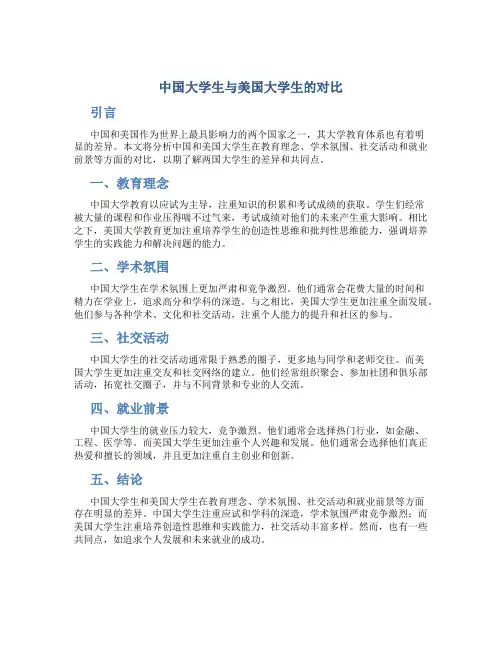
中国大学生与美国大学生的对比引言中国和美国作为世界上最具影响力的两个国家之一,其大学教育体系也有着明显的差异。
本文将分析中国和美国大学生在教育理念、学术氛围、社交活动和就业前景等方面的对比,以期了解两国大学生的差异和共同点。
一、教育理念中国大学教育以应试为主导,注重知识的积累和考试成绩的获取。
学生们经常被大量的课程和作业压得喘不过气来,考试成绩对他们的未来产生重大影响。
相比之下,美国大学教育更加注重培养学生的创造性思维和批判性思维能力,强调培养学生的实践能力和解决问题的能力。
二、学术氛围中国大学生在学术氛围上更加严肃和竞争激烈。
他们通常会花费大量的时间和精力在学业上,追求高分和学科的深造。
与之相比,美国大学生更加注重全面发展。
他们参与各种学术、文化和社交活动,注重个人能力的提升和社区的参与。
三、社交活动中国大学生的社交活动通常限于熟悉的圈子,更多地与同学和老师交往。
而美国大学生更加注重交友和社交网络的建立。
他们经常组织聚会、参加社团和俱乐部活动,拓宽社交圈子,并与不同背景和专业的人交流。
四、就业前景中国大学生的就业压力较大,竞争激烈。
他们通常会选择热门行业,如金融、工程、医学等。
而美国大学生更加注重个人兴趣和发展。
他们通常会选择他们真正热爱和擅长的领域,并且更加注重自主创业和创新。
五、结论中国大学生和美国大学生在教育理念、学术氛围、社交活动和就业前景等方面存在明显的差异。
中国大学生注重应试和学科的深造,学术氛围严肃竞争激烈;而美国大学生注重培养创造性思维和实践能力,社交活动丰富多样。
然而,也有一些共同点,如追求个人发展和未来就业的成功。
总体而言,中国和美国的大学教育各有特色,无论是中国的应试教育还是美国的综合素质教育,都希望培养出全面发展的人才。
无论是中国大学生还是美国大学生,都是年轻一代的希望,他们将引领未来社会的发展和进步。
(注:以上内容仅供参考,可以根据实际情况进行修改和扩充)。
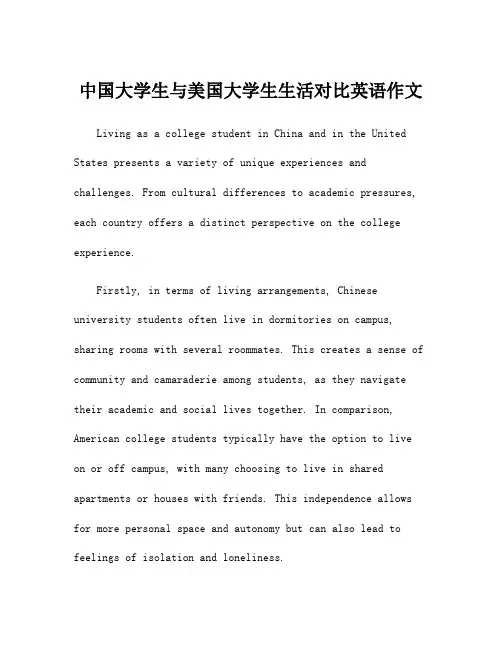
中国大学生与美国大学生生活对比英语作文Living as a college student in China and in the United States presents a variety of unique experiences and challenges. From cultural differences to academic pressures, each country offers a distinct perspective on the college experience.Firstly, in terms of living arrangements, Chinese university students often live in dormitories on campus, sharing rooms with several roommates. This creates a sense of community and camaraderie among students, as they navigate their academic and social lives together. In comparison, American college students typically have the option to live on or off campus, with many choosing to live in shared apartments or houses with friends. This independence allows for more personal space and autonomy but can also lead to feelings of isolation and loneliness.Furthermore, the academic environment in China is knownfor its emphasis on rote memorization and intense competition. Students are expected to excel in exams and constantly strive for high grades to secure prestigious jobs after graduation. The pressure to succeed can be overwhelming, leading to high levels of stress and anxiety among Chinese students. On the other hand, American universities focus more on critical thinking, creativity, and individual growth. Students are encouraged to explore their interests and pursue a well-rounded education through a variety of courses and extracurricular activities. While this approach allows for greater personal development, it can also be challenging for students who are not used to such freedom and flexibility.In terms of social life, Chinese university studentsoften participate in group activities and clubs that are organized by the school. These activities provideopportunities for students to socialize, network, and develop leadership skills. In contrast, American college studentshave a wider range of social options, including Greek life, sports teams, volunteer organizations, and more. This diversity allows students to find their niche and build a strong sense of community outside of the classroom.Overall, the college experience in China and the United States offers a unique set of opportunities and challengesfor students. While Chinese students may face intense academic pressure and competition, American students must navigate a more individualistic and diverse social environment. By exploring these differences and learning from each other's experiences, students from both countries can broaden their perspectives and grow as global citizens.。

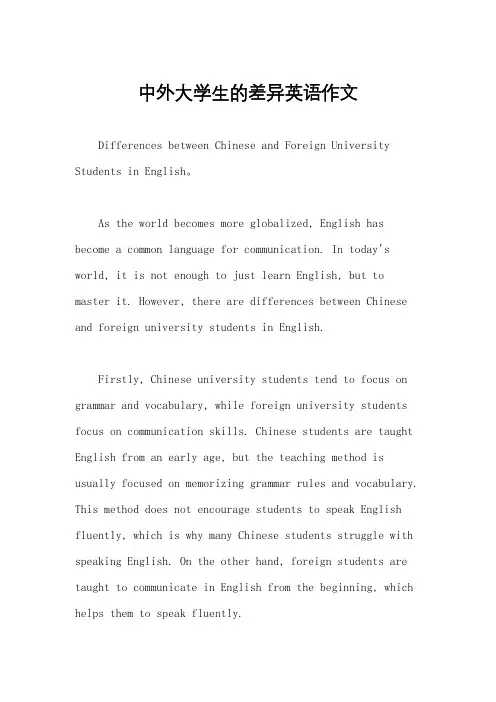
中外大学生的差异英语作文Differences between Chinese and Foreign University Students in English。
As the world becomes more globalized, English has become a common language for communication. In today's world, it is not enough to just learn English, but to master it. However, there are differences between Chinese and foreign university students in English.Firstly, Chinese university students tend to focus on grammar and vocabulary, while foreign university students focus on communication skills. Chinese students are taught English from an early age, but the teaching method is usually focused on memorizing grammar rules and vocabulary. This method does not encourage students to speak English fluently, which is why many Chinese students struggle with speaking English. On the other hand, foreign students are taught to communicate in English from the beginning, which helps them to speak fluently.Secondly, Chinese university students are more likelyto be shy and lack confidence in speaking English, while foreign university students are more confident and outgoing. Chinese students are often afraid of making mistakes and being judged by others, which makes them hesitant to speak English in public. In contrast, foreign students are more confident in their English skills and are not afraid to make mistakes.Thirdly, Chinese university students tend to be passive learners, while foreign university students are more active learners. Chinese students are used to being told what todo and how to do it, while foreign students are encouragedto take the initiative and explore new ways of learning. This difference in learning style affects their English proficiency.In conclusion, there are differences between Chineseand foreign university students in English. Chinesestudents tend to focus on grammar and vocabulary, lack confidence in speaking, and are passive learners. On theother hand, foreign students focus on communication skills, are more confident in speaking, and are active learners. To improve their English proficiency, Chinese students need to change their learning methods and become more confident in speaking English.。
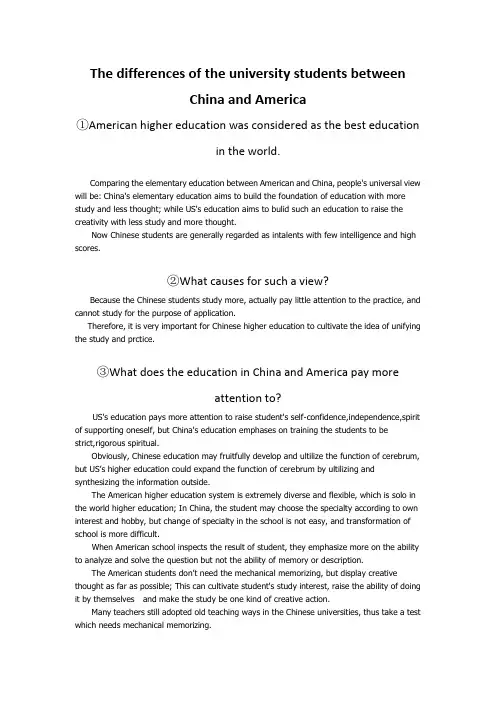
The differences of the university students betweenChina and America①American higher education was considered as the best educationin the world.Comparing the elementary education between American and China, people's universal view will be: China's elementary education aims to build the foundation of education with more study and less thought; while US's education aims to bulid such an education to raise the creativity with less study and more thought.Now Chinese students are generally regarded as intalents with few intelligence and high scores.②What causes for such a view?Because the Chinese students study more, actually pay little attention to the practice, and cannot study for the purpose of application.Therefore, it is very important for Chinese higher education to cultivate the idea of unifying the study and prctice.③What does the education in China and America pay moreattention to?US's education pays more attention to raise student's self-confidence,independence,spirit of supporting oneself, but China's education emphases on training the students to be strict,rigorous spiritual.Obviously, Chinese education may fruitfully develop and ultilize the function of cerebrum, but US’s higher education could expand the function of cerebrum by ultilizing and synthesizing the information outside.The American higher education system is extremely diverse and flexible, which is solo in the world higher education; In China, the student may choose the specialty according to own interest and hobby, but change of specialty in the school is not easy, and transformation of school is more difficult.When American school inspects the result of student, they emphasize more on the ability to analyze and solve the question but not the ability of memory or description.The American students don’t need the mechanical memorizing, but display creative thought as far as possible; This can cultivate student's study interest, raise the ability of doing it by themselves and make the study be one kind of creative action.Many teachers still adopted old teaching ways in the Chinese universities, thus take a test which needs mechanical memorizing.④The open education and enclosed education.American parents are open education that:(1)pay attention to practical exercise, emphasize the child in practice, not a lecture.Americans believe that, every child, everything makes children yourself to finish in task in the process to improve knowledge, accumulate experience, master technology, enhance ability, raises the interest expertise, and increase the confidence and sense of responsibility.(2)the value play games, Americans think playing children this age is the most important thing.In the United States, children in the activities, sports activities time is abundant, activity places is everywhere.Parents often use holiday weekend, lead the child goes out to play, play in the process of developing intelligent such as perception, imagine, judgment, reasoning and human communication and the mood adjustment, etc.Chinese parents are enclosed education:(1)to preach to give priority to, the contempt practice activities the important role.The parents and children requirement is reading, even can provide for oneself by their parents' wishes activities, and led to many Chinese children learned a lot of knowledge are useless, took to the society after what also can't.(2)outdoor activities less, because the Chinese children learn from morning till night don't finish homework do not over of homework, be homework overwhelmed.Sometimes even if want to move and is hard to find good site.。


中美大学生创新能力比较分析与思考创新是当今全球社会发展的重要驱动力之一,对于大学生来说,培养创新能力将有助于他们在未来的职业发展中具备竞争力。
中美作为全球两个重要的教育大国,大学生的创新能力水平也是外界关注的焦点。
本文将对中美大学生创新能力进行比较分析,并提出一些思考。
中美大学生创新能力的比较要从教育环境和教育理念方面入手。
中美的教育环境存在较大差异,中国的教育注重学生的基础知识学习和应试能力培养,而美国的教育更加注重培养学生的创新思维和实践能力。
这种不同的教育理念会直接影响到中美大学生的创新能力发展。
中美大学生在创新训练的机会和平台方面也存在差异。
美国的大学注重培养学生的实践能力,提供了丰富的实践机会和创新平台,例如实验室、科研项目等。
而中国的大学在这方面相对较弱,学生很难得到系统的创新训练和实践机会。
中美大学生的创新意识和思维方式也存在差异。
美国的大学重视培养学生的创造力和创新意识,注重引导学生从问题中发现机会,并从而产生创新的解决方案。
而在中国,传统的教育体系较为注重知识的灌输,学生的创新意识和创造力得不到充分的发展。
针对这些差异,我们可以从以下几个方面进行思考和改进:加强中小学教育,注重培养学生的创新意识和实践能力。
这样可以为大学生的创新能力发展奠定基础。
大学可以注重创新人才的培养,提供更多的创新训练机会和平台,例如创业实验室、科研项目等。
通过培养学生的实践能力,激发他们的创新潜力。
推动教育体制和教学方式的改革,注重培养学生的创新思维和解决问题的能力。
通过将创新教育融入到课程中,引导学生从问题中发现机会,并提供创新的解决方案。
加强国际交流与合作,借鉴和吸收国际先进的创新教育理念和经验。
通过与国外大学的合作,拓宽学生的视野,培养他们的国际化思维和创新能力。
中美大学生创新能力的比较有助于我们深入了解两国教育体系的差异,并从中发现自身的不足之处。
通过对比分析和思考,我们可以不断改进培养中大学生创新能力的方法和途径,从而为他们的未来发展提供更好的支持。
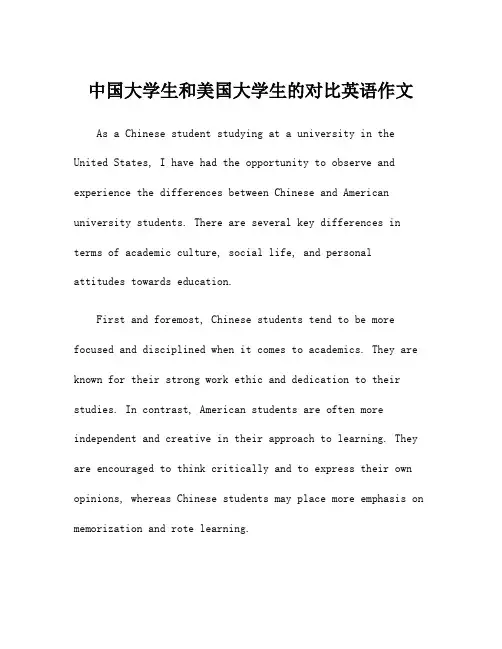
中国大学生和美国大学生的对比英语作文As a Chinese student studying at a university in the United States, I have had the opportunity to observe and experience the differences between Chinese and American university students. There are several key differences in terms of academic culture, social life, and personalattitudes towards education.First and foremost, Chinese students tend to be more focused and disciplined when it comes to academics. They are known for their strong work ethic and dedication to their studies. In contrast, American students are often more independent and creative in their approach to learning. They are encouraged to think critically and to express their own opinions, whereas Chinese students may place more emphasis on memorization and rote learning.In terms of social life, Chinese university students often have strong social bonds with their classmates and tend to form close-knit groups. There is a sense of camaraderie and solidarity among Chinese students that is less commonly seen among American students. On the other hand, American university students are known for their diversity and inclusivity, and are more likely to form friendships with people from different backgrounds and cultures.Furthermore, Chinese students generally have a more pragmatic and goal-oriented attitude towards education. Many Chinese students see their university education as a means to secure a good job and financial stability in the future. In contrast, American students often view university as a time for personal growth and exploration. They are encouraged to pursue their passions and interests, and to engage in activities that contribute to their personal development.Despite these differences, both Chinese and American university students share a common goal - to obtain a high-quality education and to prepare themselves for the challenges of the future. Each education system has its own strengths and weaknesses, and both can learn from eachother's approaches to academia. Ultimately, the experiences and perspectives of Chinese and American university students can enrich each other and contribute to a more diverse and inclusive global education community.。
中外大学学生管理工作范畴的对比CATALOGUE目录•引言•中外大学学生管理工作的共性•中外大学学生管理工作的差异•中外大学学生管理工作对教育质量的影响•中外大学学生管理工作的创新与发展趋势•结论与建议CHAPTER引言目的和背景研究意义提升我国大学学生管理工作的水平和质量更好地服务学生,促进学生的全面发展推动中外大学之间的交流与合作研究方法搜集与中外大学学生管理工作相关的文献资料,进行深入分析和归纳。
文献综述案例分析比较分析问卷调查选取若干所中外大学,对其学生管理工作进行深入调查和研究,总结其成功经验和不足之处。
对中外大学学生管理工作的范畴、内容、方法等方面进行比较分析,找出其异同点和原因。
对中外大学的学生和教师进行问卷调查,了解他们对本校学生管理工作的看法和建议。
CHAPTER中外大学学生管理工作的共性入学与注册学业管理与辅导学业管理与辅导是中外大学学生管理工作的另一个共性。
无论是国内还是国外,学校都十分重视学生的学业发展,提供一系列的学业管理和辅导服务,如选课指导、学业规划、课程辅导、毕业设计等。
这些服务旨在帮助学生合理规划学习计划,提高学习效率和质量,顺利完成学业。
总结词:学业管理与辅导是中外大学学生管理工作的核心,旨在帮助学生合理规划学业,提高学习效率和质量。
学生活动与社团管理心理咨询服务是中外大学学生管理工作的共同点之一。
在国内外,学校都为学生提供心理咨询服务,帮助他们解决学习、生活和情感上的困扰,促进学生的身心健康和全面发展。
心理咨询服务通常由专业的心理咨询师提供,采取预约制方式进行咨询和治疗。
总结词:心理咨询服务是中外大学学生管理工作的关键环节之一,旨在帮助学生解决心理问题,促进身心健康和全面发展。
心理咨询服务VSCHAPTER中外大学学生管理工作的差异国内教育理念强调集体主义和学术研究,注重学术成果和考试成绩,倾向于培养“乖学生”。
国外教育理念注重个体发展和创新能力,鼓励学生独立思考和自由发展,重视实践能力和创新思维。
中外大学生学习生活的比较(与麻省理工学院相比)1.学习挖掘技术哪家强?麻省的学生的水平源于“挖掘技术”的强悍。
麻省理工学院的学生,在他们看来没有考试60的概念,尽管“大学生科研机会规划”的课题能帮助学生作出有关专业或职业的决定,但许多学生喜欢探索与自己专业很少有或几乎没有联系的领域。
学生,在麻省应被教授们当作年轻的同事,并应及时给他们以从事独立的、有激励性的科研的机会。
很多的时候都要靠学生自己去学习,去挖掘知识。
MIT也是唯一一所学生可在每一门可获得的学科中进行研究的大学,包括艺术、社会科学和人文科学,而不是仅仅限制在自然科学和工程学领域。
因为这样的环境,麻省的学生才对知识钻研的深,才真正达到了相当的水平。
而在中国这个情况却截然不同,在我看来,这个中国的传统观念密不可分。
中国的传统倡导尊师重道,,并且在中国人的心中已经根深蒂固。
认为老师在学校里就是权威,老师说的都是对的,即使和自己的理解有偏差也要去接受,不可以去反驳,有时候有一些创新思维的人却被看做另类,这是很多人心中曾有过的想法,当然包括我在内。
而且,学生和老师之间的距离也因此被拉开了,或许我们真应该想一想“师者,所以传道授业解惑也”真正想表达的了。
我不敢肯定,但这种观念的存在或多或少可以说明为什么中国学生的创新能力和自主探究能力为什么低于国外学生。
在中国的大学里出现了这样一种现象,60分及格就好,管他呢。
只要及格了就认为万事大吉了,就没必要再去深究什么了,这种现象很常见,这或许和学校的考核制度有关,而且有时还没有那个环境让你去深究。
因此,在我看来中国大学生学习必须完成以下三个转变,即由教师指导下的学习向自主学习的转变;由接受型学习为主向接受型、创造型相结合的学习的转变;由运用摹仿性思维为主向运用创造性思维为主的学习的转变。
这样才能真正的培养有用的大学生。
2.生活精神是生活的推动。
麻省的学生在生活中有着企业家的精神。
企业家是美国经济改革的驱动力,他们把新的思想、方法和先进的技术介绍给商界和市场,并进行创造性的工作。
中美大学生对比英语作文Title: A Comparative Analysis of Chinese and American College StudentsIn the modern era of globalization, the educational landscapes of China and the United States have evolved significantly, shaping the characteristics and aspirations of their respective student populations. This essay aims to delve into the nuances that distinguish Chinese and American college students, highlighting their unique cultural backgrounds, academic approaches, and personal aspirations.Firstly, the cultural influences on these students are profound. Chinese students, raised in a society that emphasizes collectivism and respect for authority, often exhibit a strong sense of duty and obedience. They tend to prioritize group harmony and social conformity, reflecting in their academic and social behaviors. In contrast, American students, influenced by a culture that values individualism and freedom, often exhibit a stronger sense of self-expression and creativity. They are encouraged to think independently, challenge authority, and pursue theirpassions, leading to a more diverse and open-minded academic atmosphere.In terms of academic approaches, Chinese students are renowned for their dedication to study and meticulous attention to detail. They often excel in standardized tests and memorization-based subjects, reflecting a rigorous educational system that emphasizes rote learning and test scores. American students, on the other hand, are encouraged to explore a broader range of subjects and cultivate critical thinking skills. They are more likely to engage in project-based learning, hands-on experiments, and collaborative research, fostering a more innovative and practical approach to education.Moreover, the aspirations of Chinese and American college students vary significantly. Chinese students often prioritize obtaining a good job and securing a stable future, reflecting the importance of social status and economic security in their culture. They tend to favor fields like engineering, medicine, and business, whichoffer promising career prospects. American students, however, are more likely to pursue studies in areas thatalign with their personal interests and passions, such as art, humanities, and social sciences. They value thepursuit of happiness and fulfillment, often seeking to make a positive impact on society through their chosen fields. Furthermore, the social lives of these students also reflect their cultural differences. Chinese students tend to maintain close-knit social circles, often formed through shared interests, academic pursuits, or family connections. They value loyalty and trust within their social groups and often engage in collective activities. American students, on the other hand, are more likely to have diverse social networks, encompassing friends from different backgrounds and interests. They are more open to meeting new people and engaging in diverse social activities, fostering a more inclusive and diverse social environment.In conclusion, the comparison between Chinese and American college students reveals significant cultural, academic, and personal differences. These differences are shaped by the unique educational systems, cultural values, and societal expectations of each country. While both systems have their strengths and weaknesses, it isimportant to recognize and respect these differences, fostering a more inclusive and understanding academic community globally. As the world becomes increasingly interconnected, it is crucial for students from different cultures to learn from each other, bridging the gaps in understanding and promoting mutual growth.。
中外大学生思想政治教育体制比较及启示黑河学院外国语学院英语系张玲【内容摘要】大学生作为我国的中坚人才的重要组成部分,对我国的持续稳步发展,在激烈的世界竞争中获胜有重要作用。
本文通过对中外大学生思想政治教育体制的异同点对此分析,确定了开展爱国主义教育、创新思想教育模式和改善思想政治教育体制等措施,优化我国大学生思想政治教育工作,满足高校思想政治教育的全面需求。
【关键词】教育体制思想政治爱国主义世界各国对于大学生的思想政治教育都是尤为重视,其教育水平及程度往往能够反映出一个国家的发展水平。
在社会的快速发展中,大学生思想政治教育体制面临着不断的挑战。
为确保大学生能够快速适应目前的社会形势,应创新大学生的思想政治教育体制,打造一套科学有效的教学机制。
通过对国内外思想政治教育体制的对比分析和研究,找出我国体制不足之处,并借鉴国外的优势经验来进行改进,确保大学生思想政治教育质量得到全面的改善。
一、中外大学生思想政治教育体制的对比分析目前,国内的大学生思想政治教育体制以集中领导制为主要模式,国外则是分权领导制为主要模式。
两种不同的教育体制由着不同的社会、经济、政治、文化背景所形成,思想政治教育体制有着共同的相同点,也有着不同之处,以下就对两种教育体制的特征进行详细分析。
(一)国内大学生思想政治教育体制特征大学生的思想政治教育体制是一个集成的系统机制,明确了该教育的具体开展管理工作内容,包括制定教育的宗旨、形式、方法等,国内的大学生思想政治教育体制由中共中央和国务院出台相关内容来规定相关内容,从国家层面重视该项工作,并通过有效的组织架构及各个不同层级之间的部门推进和落实大学生思想政治教育工作。
在我国大学生的思想政治教育遵行的是统一领导制的制度,以党政统一的方式来进行开展。
我国大学生思想政治教育以中国共产党为主要核心,以地方党委机关为实践载体,各层面全力执行领导战略机制,共同推进高校大学生的思想政治教育工作。
在实践层面,主要通过各个高校的党委来进行领导工作,根据中央精神开展思想政治教育。
双语:对比中日韩三国大学生Over the weekend, 30 Japanese universities took part in the International Education Expo in Beijing. ROK, meanwhile, expects an influx of Chinese students, thanks to new exchanges between the two countries。
上周末,30所日本大学参加了北京国际教育展。
同时,由于中韩两国的进一步交流,预计韩国也将迎来大批的中国留学生。
Official figures show that in 2008 Chinese accounted for more than 60 percent of the foreign students in ROK and over 70 percent of those in Japan。
官方数据显示,2008年在韩留学生中,中国留学生所占的比例已经超过60%;在日本,这一比例高于70%。
While Chinese have many things in comm on with students in these two countries,they still encounter surprises every now and then. We explored someof these differences in interviews with people from all three countries:尽管中国学生与日韩学生有着许多共同之处,但还是不时有意外状况发生。
通过采访,我们发现三个国家间确有一些不同之处:Seniors get respect 学长受尊敬Remember young people nodding at their elders andgiving way to them on campuses in Japanese and Korean TV dramas?Well, that's no exaggeration。